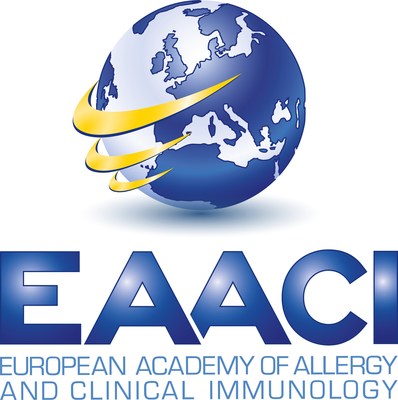ZURICH, March 23, 2021 /PRNewswire/ -- On the occasion of World Meteorological Day 23 March 2021, the European Academy of Allergy Asthma and Clinical Immunology (EAACI), the European Federation of Allergies and Airways Diseases (EFA), and the World Meteorological Organisation (WMO) are joint in the global challenge of tackling climate change, mitigating its health-related impacts towards the enhancement of patients' quality of life.

Air pollution shortens the lives of around 7 million people each year, and nine out of 10 people breathe air polluted by traffic emissions, industry, agriculture or incineration, according to WHO.
WHO estimates that by 2050, half of the world's population will be affected by asthma and allergy. Human-caused climatic change strongly contributes to this rising frequency through direct and indirect effects.
Direct effects
Weather changes may affect the airways directly by cooling or irritation. Exacerbations of asthma and rhinitis have been shown to be precipitated by low temperature and humidity or by a sudden fall in temperature. Asthma admissions increase following low or high barometric pressure and rainfall.
Indirect effects
Climate change is also a huge threat to the well-being of patients with asthma and allergy through increased exposure to risk factors, namely through worsening ambient air pollution and altered local and regional pollen production, mould proliferation and biodiversity loss. The pattern of the effects varies regionally depending on latitude, altitude, rainfall and storms, land-use patterns, urbanisation, transportation, and energy production.
Increased air pollution. Significant variations in the temperature, humidity, wind, and precipitations that accompany climate change profoundly impact air quality via modifications in the transport, dispersion, and conversion of air pollutants. Atmospheric warming increases ground-level ozone in many regions. Related phenomena - urbanisation, perturbed ventilation and increased confinement indoors, wildfires and sandstorms, - are at the origin of worsening of gas and particulate matter (PM) exposure. All these events put individuals at an elevated risk of exposure to polluted air, resulting in the development or aggravation of asthma and allergic diseases.
It is well established that air pollution exposure, especially fine PM and ozone, exacerbates pre-existing asthma and rhinitis. A causal relationship between new onset of childhood asthma and long-term exposure to outdoor air pollution, especially traffic-related, such as nitrogen dioxide (NO2), fine PM and black carbon, has been reported. Recent data also suggest that long-term exposure to air pollution causally contributes to adult-onset asthma. Air pollution has recently been shown to be a causal factor in the induction, progression and death from asthma of the 9-year-old London girl, Ella Kissi-Debrah. Even short-term exposures to PM2.5, NO2, and ozone may increase asthma mortality risk.
More recently, air pollution, especially truck traffic emissions, has been related to an increase in atopic dermatitis prevalence.
Higher pollen count and allergenicity increase the risk of pollen sensitization and allergy in susceptible individuals. Global warming, drought, extreme rainfall, wind bursts, thunderstorms, air,water, and soil pollution, and land-use changes, profoundly impact plant pollen production, release, dispersion and quality. Increasing concentrations in the atmospheric carbon dioxide (CO2), involved in the photosynthesis process together with increased plant biomass and flowering, result in a higher concentration of airborne pollen. Increasing temperatures lead to an earlier and prolonged pollen season. Air pollutants increase the allergenic load per pollen and change allergen composition.
Geographic and temporal changes in temperature and humidity influence vegetation patterns and plant physiology and modifies pollen distribution. Pollen can travel hundreds of kilometres and, with changing weather patterns and altered species distribution, it has become possible for people to be exposed to new and foreign pollen species from other geographical regions and countries.
Increased mould spores in the air. Change in climate and the correlated warm and humid conditions affects the quantity, intensity, and frequency of precipitation of moulds, which are well-known risk factors for severe asthma.
Thunderstorm-asthma. Sudden and massive allergen release from pollen and moulds after a storm resulted in epidemics of thunderstorm asthma overwhelming the emergency departments in a few hours.
Loss of biodiversity. Climate change is a primary driver of biodiversity loss, favoring the development of asthma and allergy through the lack of modulation of the immune system. Conversely, the loss of biodiversity contributes to climate change, for example deforestation increases carbon dioxide, the major "human-produced" greenhouse gas.
On World Meteorological Day, EAACI calls for:
·Improved air quality, which should be promoted through green-friendly industrial upgrading, agricultural method changes, vehicle and fuel renovation and interventions, healthy city development with increased nature relatedness, revegetation with non-allergenic plants, and smart inner city traffic.
· Interventions at population-based level such as health promotion activities (bicycling, walking, exercise and healthy diet) together with individualised interventions to lower personal exposures should be further prioritised
·Real-time pollen and mould spore monitoring coupled with alert systems is urgently needed.
·Protection and conservation of natural elements and of biodiversity is of utmost importance.
The recently created EAACI Research and Outreach Committee with its Environment Working Group, together with the Aerobiology and Pollution and the One Health Working Groups constantly develop guidelines and recommendations to tackle the profound impact of climate change on allergic diseases and asthma.
"Allergy and asthma patients are the radars of our environments. On World Meteorological Day we stand with all the researchers and clinicians that are scrutinising the effects climate change has on our health, to decrease the impact, mitigate the effects and enhance solutions to improve our quality of life. As a patient representative, I call on authorities in Europe to set up and resource policies to address climate-change related diaseases. Tools such a real-time pollen monitoring systems should be compulsory, not only to assess the impact climate change has on biodiversity, but also to inform the most vulnerable about aeroallergens so that we can take action for our health on a daily basis", says European Federation for Airways Diseases (EFA) President Mikaela Odemyr.
"The World Meteorological Organization is part of the global commitment spearheaded by the World Health Organization to reduce deaths due to air pollution by two thirds by 2030. Specifically, WMO is working to strengthen the quality and availability of pollution observations, enable provision of air quality forecast and advisory services and incorporate health impacts in key scientific assessments on climate and climate change. Actions to improve air quality and tackle climate change are both a top global priority. We can mitigate both problems with the same means by getting rid of fossil energy," says Petteri Taalas, WMO Secretary General.
WHO and WMO have an agreement to improve health outcomes through better weather, climate, atmospheric and hydrological services and through improved monitoring and management of environmental health risks. These include sand and dust storm warnings and forecasts and pollen monitoring networks.
The European Academy of Allergy and Clinical Immunology (EAACI) is the leading professional association dedicated to improving the health of people affected by allergic diseases and asthma. With more than 13,000 members from 124 countries and over 50 National Allergy Societies, EAACI is the primary source of expertise in Europe and worldwide for all aspects of allergy and asthma. www.eaaci.org
The European Federation of Allergy and Airways Diseases Patients' Associations (EFA) is the voice of over 200 million people living with allergy, asthma and chronic obstructive pulmonary disease (COPD) in Europe. We bring together 39 national associations from 25 countries and channel their knowledge and demands to the European institutions. We connect European stakeholders to ignite change and bridge the policy gaps on allergy and airways diseases so that patients live uncompromised lives, have the right and access to the best quality care and a safe environment. www.efanet.org
Chiara Hartmannchiara.hartmann@eaaci.org
Photo - https://mma.prnewswire.com/media/1471881/EAACI.jpg
Logo - https://mma.prnewswire.com/media/1471880/EAACI_Logo.jpg

